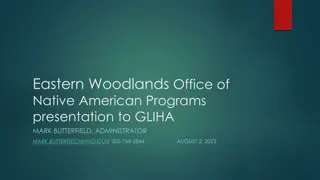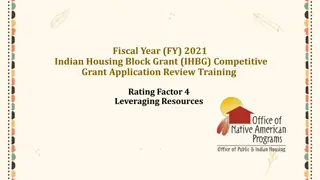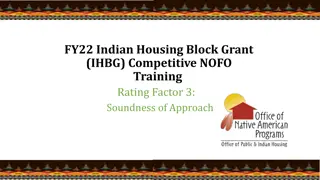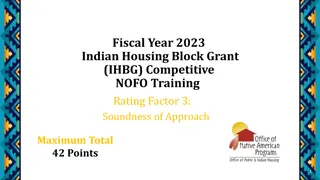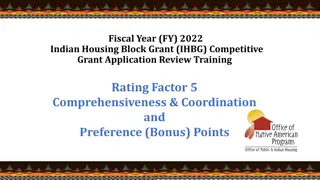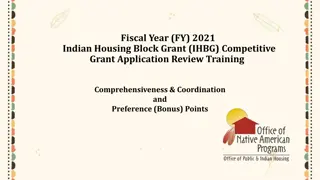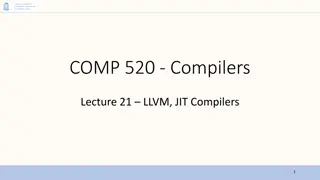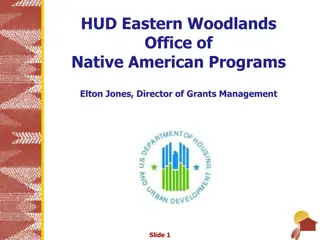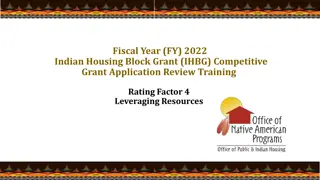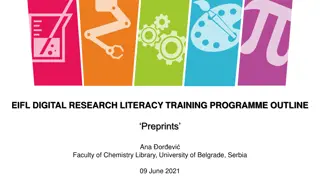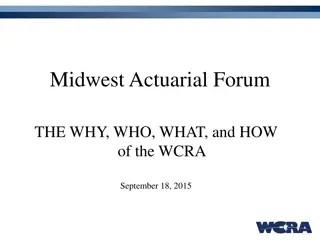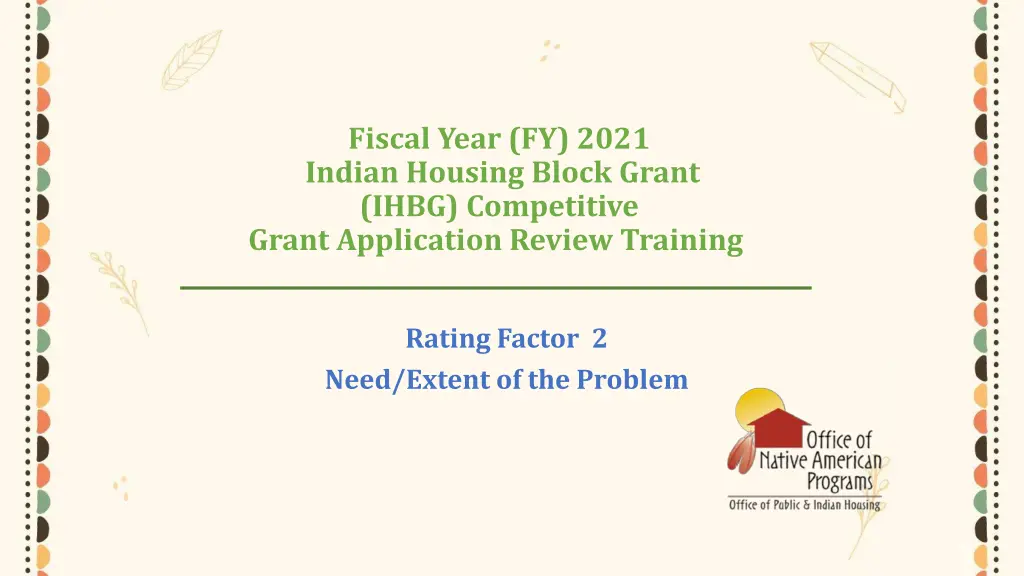
Indian Housing Block Grant Application Review Training FY 2021
Explore the Indian Housing Block Grant Competitive Grant Application Review Training for FY 2021. Delve into Rating Factor 2, focusing on the Need/Extent of the Problem. Learn about the subfactors under this rating factor, such as Identified Needs and Supporting Data, Project Beneficiaries, Past Efforts, Sustainability, and more. Gain insights into addressing identified needs of American Indian and Alaskan Native households, housing shortages, income levels, and project activities to meet these needs effectively.
Download Presentation

Please find below an Image/Link to download the presentation.
The content on the website is provided AS IS for your information and personal use only. It may not be sold, licensed, or shared on other websites without obtaining consent from the author. If you encounter any issues during the download, it is possible that the publisher has removed the file from their server.
You are allowed to download the files provided on this website for personal or commercial use, subject to the condition that they are used lawfully. All files are the property of their respective owners.
The content on the website is provided AS IS for your information and personal use only. It may not be sold, licensed, or shared on other websites without obtaining consent from the author.
E N D
Presentation Transcript
Fiscal Year (FY) 2021 Indian Housing Block Grant (IHBG) Competitive Grant Application Review Training Rating Factor 2 Need/Extent of the Problem 1
Rating Factor 2: Need/Extent of the Problem Up to 25 points 2
Rating Factor 2: Subfactors 2.1 Identified Needs and Supporting Data (Up to 9 points) 2.2 Project Beneficiaries (Up to 3 points) 2.3 Past Efforts to Address Identified Need (Up to 3 points) 2.4 Sustainability (Up to 5 points) 2.5 New and Previously Unfunded Applicants (Up to 5 points) 3
Subfactor 2.1: Identified Needs and Supporting Data (Up to 9 points) 2.1.a. Identified Needs (Up to 6 points) 2.1.b. Supporting Data (Up to 3 points) 4
Subfactor 2.1.a.: Identified Needs (Up to 6 points) The applicant must: Describe in detail the need of the Indian tribe and how the project or activities will help address such need. Limit its description to the following factors for determining needs, as identified in this NOFO. Identify the following factors that are relevant to its proposed project or activities when describing need. 5
S Subfactor 2.1.a.: Identified Needs (Continued) (Up to 6 points) Examples of identified need factors to address in the application. (Address only factors relevant to project); 1. American Indian and Alaskan Native (AIAN) households with housing cost burden greater than 50 percent of formula annual income in its formula area (as defined under 24 CFR 1000.32). 2. AIAN households which are overcrowded or without kitchen or plumbing in its formula area. 3. Housing Shortage in its formula area. 4. AIAN households with annual income less than or equal to 30 percent of formula median income in its formula area. 5. AIAN households with annual income between 30 percent and 50 percent of formula median income in its formula area. 6. AIAN households with annual income between 50 percent and 80 percent of formula median income in its formula area. 7. Number of AIAN person in its formula area. 6
Subfactor 2.1.a.: Identified Needs (Continued) (Up to 6 points) Applicant must describe how each proposed project or activity will address each need identified. Example activities may include; New construction Infrastructure Rehabilitation, Acquisition of existing housing units that increase housing stock, or Other NAHASDA eligible activities, etc. 7
Subfactor 2.1.a.: Identified Needs (Continued) (Up to 6 points) Acquisition - to acquire existing housing units that increases affordable housing stock, applicant must: 1) Indicate the total number of units; 2) Demonstrate that the new units will result in an increase in the affordable housing stock (without offset by the disposition or demolition of other affordable housing units) 8
Subfactor 2.1.a.: Identified Needs (Continued)(Up to 6 points) s) Indian tribes that annually receive minimum needs funding must describe how: proposed project or activities will address the needs of low-income households needs are addressed in the certification that they are required to submit in the IHP pursuant to 24 CFR 1000.328. 9
Subfactor 2.1.b.: Supporting Data (Up to 3 points) Identified needs supported by final published U.S. Decennial Census data and American Community Survey (ACS) data, and any other data used calculate the FY 2021IHBG formula allocations. Identified needs may be supported by any data included in a successful IHBG Census challenge previously approved by HUD before August 24, 2021. Copy of all supporting data (including census or formula allocation) must be included in the application. In accordance with 24 CFR 1000.328, tribes that receive minimum needs funding because of insufficient data must certify the presence of any households are at or below 80 percent of median income in their formula area. 10
Subfactor 2.2: Project Beneficiaries (Up to 3 points) Applicant must explain; 1. How eligible families will benefit from the proposed projects, and 2. The number of families that will be assisted. Applicant must provide supporting documentation (such as a waiting list) demonstrating that eligible families that will benefit from the project or activities being proposed either have been identified and will be able to be served with grant funds under this NOFO. Applicant must describe how it will identify eligible families that will benefit from the project or activities being funded in the future (such as putting a policy in place to identify eligible families). 11
Subfactor 2.3: Past Efforts to Address Identified Need (Up to 3 points) Applicant must indicate whether it has; 1) actively pursued the proposed project of similar activity in the past, or 2) a new undertaking based on this NOFO. The narrative must include an explanation of the time elapsed since the applicant has actively pursued the project or similar eligible activity. If the applicant has not pursued the project in the past, then narrative should explain the reasons why it is an opportune time to actively pursue the project. All applicants must discuss any past or potential barriers towards implementing the project and strategies for overcoming possible hurdles if awarded IHBG competitive funds. 12
Subfactor 2.4: Sustainability (Up to 5 points) The applicant must describe, its plans to operate and maintain the project upon completion and secure future funding for project. its plan to ensure, according to Section 205 of NAHASDA, that each housing unit under IHBG Competitive remain affordable for useful life of property. (NEW) Includes applicants proposing infrastructure projects, which will support affordable housing after period of performance. how the project furthers its goals for implementing its IHBG program. 13
Subfactor 2.5: New and Previously Unfunded Applicants (Up to 5 points) New Subfactor from FY 2020 NOFO. Applicant will receive points if it; applied but did not receive a FY 2018/2019 or FY 2020 IHBG Competitive grant award, or did not apply. Applicant (or its tribe/TDHE) will receive zero (0) points if received a FY 2018/2019 or FY 2020 IHBG Competitive grant award. HUD will also review the corresponding tribe or TDHE when awarding points. 14




